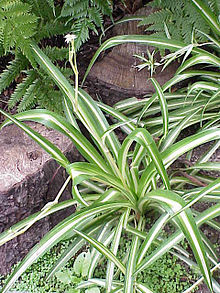Chlorophytum comosum
| Chlorophytum comosum | |
|---|---|

| |
| Chlorophytum comosum 'Variegatum' | |
| Scientific classification | |
| Kingdom: | Plantae |
| Clade: | Tracheophytes |
| Clade: | Angiosperms |
| Clade: | Monocots |
| Order: | Asparagales |
| Family: | Asparagaceae |
| Subfamily: | Agavoideae |
| Genus: | Chlorophytum |
| Species: | C. comosum
|
| Binomial name | |
| Chlorophytum comosum | |
Chlorophytum comosum, often called the spider plant, is a species of Chlorophytum native to South Africa.
Spider plants have long narrow leaves that are 20–40 cm (8–15 in) long and 5–20 mm (0.2–0.8 in) broad, growing from a central rosette. At the spot where a leaf would normally develop a node, the plants produce adventitious roots down into the soil, and new above-ground shoots. It also produces branched stolons with small white flowers and baby plantlets.
It is a popular houseplant. The most widely grown is the variegated cultivar 'Variegatum', with one or two broad yellowish-white bands running along the length of each leaf, but natural, entirely green plants are also grown. The Spider Plant is an especially popular plant with beginners, as it is easy to grow and propagate and is very tolerant of neglect, being able to thrive in a wide range of conditions.
Spider plants have also been shown to reduce indoor air pollution.[2]
-
Flower of C. comosum
-
Fleshy rhizomes of C. comosum
See also
References
- ^ "Chlorophytum comosum information from NPGS/GRIN". www.ars-grin.gov. Retrieved 2008-03-17.
- ^ B. C. Wolverton, Rebecca C. McDonald, and E. A. Watkins, Jr. "Foliage Plants for Removing Indoor Air Pollutants from Energy-efficient Homes". Retrieved 2007-05-03.
{{cite web}}: CS1 maint: multiple names: authors list (link)


